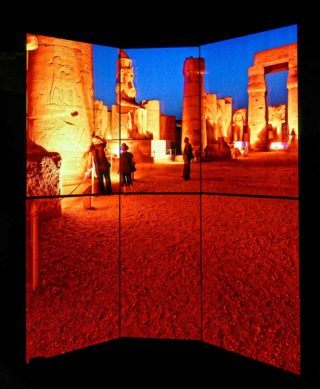HearstCAVE
by Erica Chen
 The Student Technology Fund committee at UC Berkeley recently awarded Research IT a grant for the two-year project, Student 3D/Visualization Teams for Campus Museums, which will be run in collaboration with the Phoebe A. Hearst Museum of Anthropology.
The Student Technology Fund committee at UC Berkeley recently awarded Research IT a grant for the two-year project, Student 3D/Visualization Teams for Campus Museums, which will be run in collaboration with the Phoebe A. Hearst Museum of Anthropology.
The project builds on photogrammetry work done to create 3D models of Egyptian sarcophagi by Professor Rita Lucarelli of the Near Eastern Studies department and her graduate student Kea Johnston, who recently gave a talk on the workflow she developed with BRC support at the CaVraCon ’17 conference.Research IT plans to use the funds to hire and train a student team to create interactive 3D content from the Hearst Museum’s collection of 3.8 million artifacts. These will be hosted in a Unity application for the HearstCAVE, the museum’s visualization platform.
The HearstCAVE is available for public viewing and interaction during our regular open hours inside the Museum’s Gallery.
This project is funded by the University of California Office of the President’s Research Catalyst Award for At-Risk World Heritage and the Digital Humanities, a collaboration between UC Berkeley, UCSD, UCLA, and UC Merced to document at-risk archeological sites with Principal Investigator (PI) Thomas E. Levy at UCSD and co-PI Benjamin Porter at UC Berkeley. A student team currently engaged in creating 3D content from the PAHMA collection is funded by the NSF-sponsored Pacific Research Platform project, with Camille Crittenden of CITRIS as co-PI. The Student Technology Fund award will be augmented by Research IT’s contribution to hiring and training the next-generation team.
 Chris Hoffman, Program Director of Research Data Management & Museum Informatics, says that Research IT is excited to collaborate with other UC campuses through this project, and to provide opportunities to undergraduates. By enabling students to hone their skills with booming 3D and Virtual Reality technologies while also helping the Hearst Museum add content to their visualization environment, this project makes an impact on undergraduates, museum visitors, and researchers.
Chris Hoffman, Program Director of Research Data Management & Museum Informatics, says that Research IT is excited to collaborate with other UC campuses through this project, and to provide opportunities to undergraduates. By enabling students to hone their skills with booming 3D and Virtual Reality technologies while also helping the Hearst Museum add content to their visualization environment, this project makes an impact on undergraduates, museum visitors, and researchers.
This exhibit is located inside the Hearst Museum’s Gallery.
